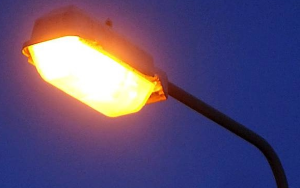People have been contacting me to express their annoyance that street lights are currently turning off between 10.30pm and 11pm. That’s an hour earlier than the 12pm shutdown set out in Shropshire Council’s policies.
This morning I have received a detailed explanation from Jason Hughes, the council’s street lighting champion. It turns out its all down to technology – pretty dumb technology as it happens. But the council is looking at new tools to improve the way the lights operate. This smart technology (no jokes about brighter street lights please) will allow managers in Shirehall to control lights and identify faults centrally.
Here is an edited version of Jason’s explanation, which sheds light on the current problem:
“When the lighting is first converted to part-night lighting, the photo-cell (PEC) will turn the light on at dusk and operate through until approximately midnight when it will then switch off until approximately 5:30 a.m. at which time it will reignite and operate through until dawn.
These timings are approximate due to the way the PEC operates. PEC’s do not have an internal clock, nor are they able to pick up details of the astronomic clock at Rugby. Instead they use algorithms to determine the time by looking at the length of day between dusk and dawn to establish when midday occurs. The PEC will then be able to calculate the length of time needed to pass from midday before it needs to switch off. Equally it knows that 5.5 hours later it needs to switch back on. As this calculation is made daily it can be affected by extremes of weather conditions, for example if the skies are overcast at dawn but clear at dusk, or vice versa. This can mean minor changes to the switch on/off times and these can vary as much as ±15 minutes around midnight.
“The PEC determines whether it should operate with Day Light Saving (BST) or without (GMT) and sets itself by the following procedure of using the length of day to:
If the length of day is greater than 12 hours then the PEC operates to BST timings;
If the length of day is less than 10 hours the PEC operates to GMT timings;
If the day length is between 10-12 hours and the length of day is increasing the PEC changes to GMT as we would be coming from winter but have not reached BST yet;
If the length of day is between 10-12 hours and the length of day is decreasing then the PEC changes to BST timings, as we are coming from summer but have not reached GMT yet.”
“Unfortunately the PEC has a period of when it continues to operate in either BST or GMT before it can categorically change to the opposing timings. When the transition is from BST to GMT the period of ‘hesitation’ occurs in the evening and when the transition is from GMT to BST it occurs in the early hours of the morning. Although the manufactures are stating it could take between 10-14 days to compensate, we noted that on-street this was actually reduced down to 5-8 days.”
“Looking towards the future of street lighting in Shropshire, we are currently trialling a Central Management System which will control switching times remotely and has been running successfully over the last 10 months. This system can monitor each individual street light for faults, provide an opportunity to dim the lanterns through different stages during the evening and most importantly provide an accurate timing platform to control on/off times in terms of part-night lighting. If deployed extensively across the county, this could also provide revenue saving reducing night scouts and improve fix times as faults will be reported automatically. This, as with all major projects, will be subject to capital funding being made available and the continued success of the trial.”

